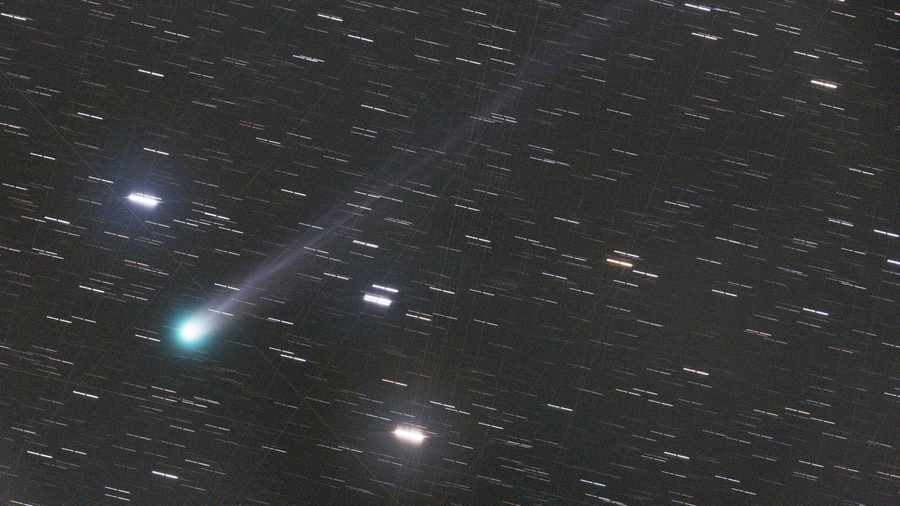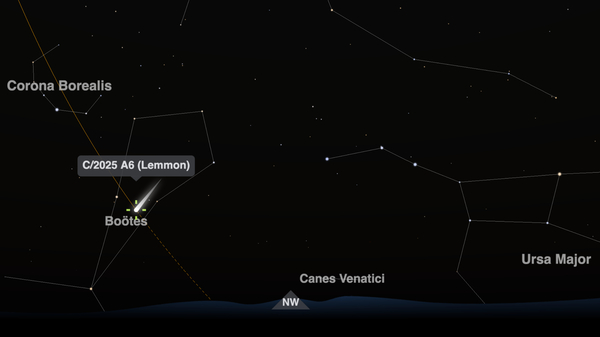
On the evening of October 19, mungfali.galihkartiwa07.workers.dev’s Brendan Goodenough captured C/2025 A6 (Lemmon) posing next to an aurora. Brendan is based in the far north of Norway; he got this image from his balcony at around 20:00 (8 pm) local time using an 8-second exposure.

A Second Naked-Eye Comet for October?
A comet with an eye-catching name will move through the morning and evening sky during October 2025. C/2025 A6 (Lemmon) will make its closest approach to Earth on October 21—just one day after another comet, C/2025 R2 (SWAN), is at its closest to our planet.
Comets are well known for doing their own thing, and it’s difficult to predict their brightness. C/2025 A6 (Lemmon) could reach a magnitude of around 4.0 or brighter, which means it has a reasonable chance of becoming a naked-eye comet.
This is a comet that favors skywatchers in the Northern Hemisphere. Observers will need a dark sky, away from city lights and other sources of light pollution. And remember that fuzzy comets can be harder to spot than twinkling, point-like stars. If the naked eye doesn’t work, a pair of handheld binoculars should reveal C/2025 A6 (Lemmon).
Why “Lemmon”? It’s because the comet was discovered by an automated telescope system stationed at the summit of Mount Lemmon in Arizona, USA.
How to Spot C/2025 A6 (Lemmon)
During the first half of October, for mid-latitudes in the Northern Hemisphere, C/2025 A6 (Lemmon) might be visible during the night, and before dawn in the eastern half of the sky. During the second half of the month, the comet might appear after sunset in the western half of the sky, close to the horizon.
You can use our Night Sky Map to find C/2025 A6 (Lemmon) from your town or city.
Click the calendar to select the date, and drag the marker back and forth along the timeline to see how the comet moves across the sky. Use the plus and minus buttons to zoom in and out.
Around October 21, C/2025 A6 (Lemmon) will be near the famous Big Dipper group of stars (also known as the Plough in the UK and Ireland). In fact, the last two stars in the handle of the Big Dipper will point in the direction of the comet—as you can see in our screenshot below.

C/2025 A6 (Lemmon) Facts & Figures
| Discovery | 3 Jan 2025 |
|---|---|
| Discovered by | Mount Lemmon Survey / Carson Fuls |
| Perihelion | 8 Nov 2025 |
| Closest approach to Earth | 21 Oct 2025 |
| Brightest magnitude | 4.0 (estimate) |
Frequently Asked Questions
What is a comet?
Comets are dusty, icy, rocky objects—often around one to ten kilometers in size—that orbit the Sun.
Read more about comets
What is magnitude?
The brightness of an astronomical object as seen from Earth is called its apparent magnitude. Two important things to know:
-
Magnitude uses a reverse scale: The lower the number, the brighter the object—in the case of very bright objects, the number can go below zero
-
Magnitude uses a logarithmic scale: If the magnitude of an object decreases by 1, it becomes about 2.512 times brighter
So although it may seem as though the Sun (magnitude -27) is only twice as bright as the Full Moon (magnitude -13), it is in fact 400,000 times brighter. (The difference between -27 and -13 is 14, and 2.512 multiplied by itself 14 times is 2.512^14, which is roughly 400,000.)
Below are some approximate examples of the average magnitude of objects as seen from Earth.
-
The Sun: -27
-
Full Moon: -13
-
Venus: -4.1
-
Jupiter: -2.2
-
Sirius (the brightest star): -1.5
-
Polaris (the Pole Star): +2.0
-
Limit of naked eye (with good conditions): +6.5
-
Neptune: +7.8
-
Limit of handheld binoculars: +9.5
What is perihelion?
Perihelion is the point where a comet—or other astronomical body—is at its closest to the Sun.
Perihelion and aphelion
What are the rules for comet names?
Those complicated-looking names are based on a set of rules from the International Astronomical Union. Let’s take C/2024 G3 (ATLAS) as an example:
-
C/ refers to a non-periodic comet. This means the comet hasn’t been observed before, and its orbital period (the amount of time it takes to complete one orbit around the Sun) is greater than 200 years
-
2024 is the year the comet was discovered
-
G indicates the half-month it was discovered—in this case, the first half of April. The first half of January is “A,” the second half of January is “B,” the first half of February is “C,” and so on. The letter “I” is skipped to avoid confusion with the number “1”
-
3 means it was the third comet discovered in that half-month
-
ATLAS is the name of the instrument that made the discovery—in this case, ATLAS is a system of robotic telescopes. Comets can also be named after people: for example, C/2024 E1 (Wierzchos) was discovered by the Polish astronomer Kacper Wierzchoś